Leia uma versão em português aqui.
About fifteen years ago I fell in love with watersheds. Then, my passion extended to the forests and ecosystems that sustain them. Then, I discovered the urban waters and biodiversity, and consequently urban ecology, when I started researching on urban blue-green infrastructure and how people related to their environment. From then on, the complex urban landscape has driven me to a new world where social and ecological issues are intertwined, and offer an incredible universe for researching, learning and connecting to other people that are involved in transforming cities in all scales.Baixo Rio presents a new opportunity to work from the bottom-up, together with Urban Planning and other city departments to enable a sustainable and participative urban transformation.
I have been fascinated about how grassroots movements and bottom-up approaches have been changing landscapes in many cities. At the same time, I have been very frustrated that in my city, Rio de Janeiro, people haven’t broken the bubble of the powerful decision-makers in the preparation to host the international sports events[1]: 2014 Soccer World Cup and 2016 Olympic Games. Arrangements that privileged some companies were always taken behind closed doors. The results are expressed in a violent and neglected city. The reasons are being acknowledged during the process of investigating the huge scandal of investments that focused on the city as a big business for few powerful people. Corruption blocked all grassroots movements to participate and choose greener and more sustainable projects, including the ones that I have participated on. As I have written about before at TNOC, many dreams and movements I have participated in the last 5 years didn’t get beyond the paper phase.
Now, I have an opportunity to apply my knowledge and expertise in a new venture that aims to transform the urban landscape, connecting people, waters and biodiversity, oriented to local businesses, with food production, arts and culture.
It is a chance to transform the city into a biophilic city! I am a member of the Steering Committee of the Biophlic Cities Project, led by Timothy Beatley (who is also a contributor of TNOC with several essays about the theme), which calls for the role of nature in the city as a priority to make it livable, sustainable, resilient and offer high quality of life and well-being. In his words: “A biophilic city is a natureful city. It puts nature at the core of its design and planning, not as an afterthought or an ornament. It’s key to everything that happens in the city.”
Baixo Rio, is an experiment in participatory urban transformation
Rio Comprido neighborhood
In this article, I will focus on a specific case of urban transformation that I am involved in right now. It is located in Rio de Janeiro. It is a challenging area named Rio Comprido (Long River). Below is a brief outline of the neighborhood’s present context and challenges with pollution and livability:
- The neighborhood divided by a long viaduct, or canal, what remains of a diverted and channelized Comprido River
- Dereliction and neglect
- The canal is narrow, and the water is polluted by sewage and diffuse contamination by rainwater run-off
- Floods occur during storms, due to the steep slopes that surround the area and the extensive paving of the land cover
- The canal is not visible to people who drive in the upper fly-over
- Heavy traffic congestion on weekdays under the bridge
- Ghost streets with no people most of the time, especially during the weekends
- Not friendly to walk, the cars and buses have total priority, and lack any attractiveness
- Surrounded by 22 low-income communities (slums), where gangs fight against each other, and residents fear for their lives
- The neighborhood is unsafe (actually nowadays the whole city is insecure—the army was called to try to restore order where drug traffickers and militia are the main rulers of most of the urban territory)
- Extremely noisy
- The air is heavily polluted
Despite these challenges, there is a huge opportunity to regenerate the urban landscape adjacent to the canal and spread to the vicinity. Besides mixed middle- to low-income residential areas, the neighborhood houses small businesses, larger companies, and educational institutions that have been suffering with the violence that directly or indirectly affect their operations.
Academic proposition
About two years ago, Lucas Araújo, an architecture and urbanism undergraduate student asked me to be his co-advisor on his final project. He wanted to develop a plan and design for green infrastructure in an area that was extremely impacted by the hard, hard engineering of the early 20th Century, when the Comprido river that names the neighborhood was diverted and channelized to enable the urbanization and the construction of streets on its two newly built concrete banks. In the early 1970’s the opening of a tunnel to connect north and south regions of the city led to the construction of a 2.6 km long viaduct over the canal, dividing and destroying the nice neighborhood close to the downtown region.
The change was abrupt and the area became a concrete and asphalt “nowhere”, where cars and busses circulate in a dark and polluted environment, not suitable for life. The area has been decaying for the last five decades and nothing has been done to change the inhospitable landscape.
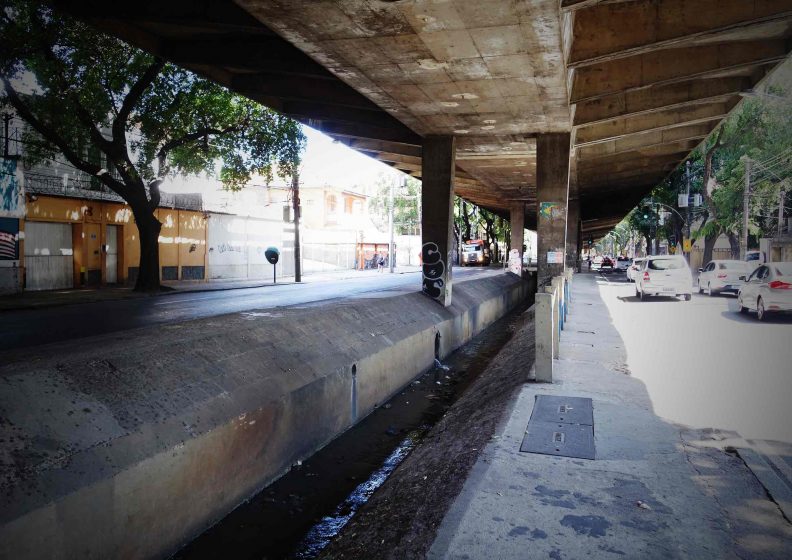
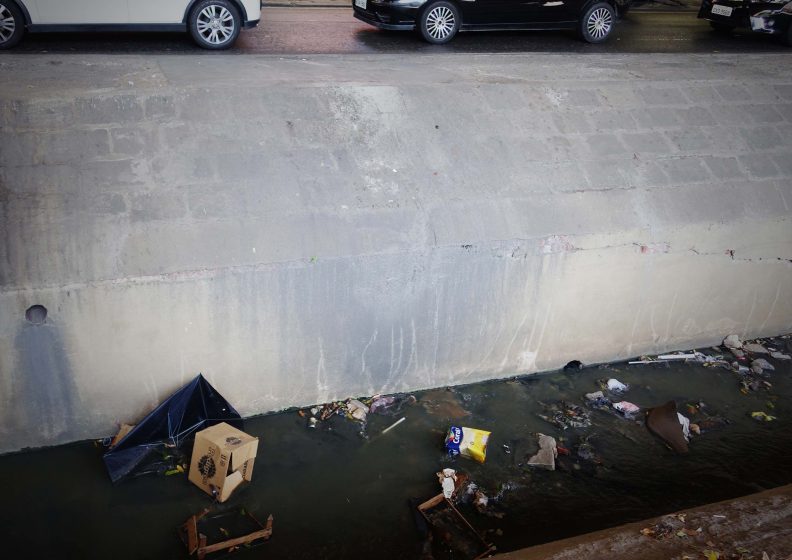
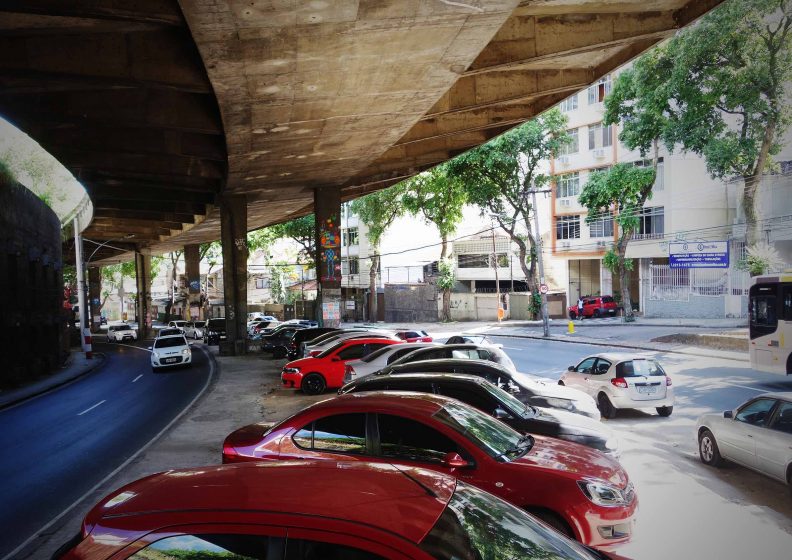
During the following year, I had a chance to learn about the area, the challenges and opportunities that were hidden beneath the elevated highway. Lucas had a developed a very interesting process to accomplish his challenging project. During their undergraduate work, the students have very limited contact with landscape architecture and landscape planning and design. In spite of these academic limitations, the resulting plan was a robust proposition founded in the ecological and social systems of the ‘neighborshed’ (watershed + neighborhood). The project focused on the main square of the area, connected both sides of the canal, converted streets to pedestrian areas with components of local green infrastructure, such as rain gardens and bioswales, naturalized river banks, and much more.
Baixo Rio: seeing the city upside down
Last June I received an email from Guto Santos (Architect-Urbanist, head of Livre Arquitetura) telling me how passionate and motivated he was to transform the neglected area, Rio Comprido. He had worked for about 5 years in an office located close to the very end of the canal, and had walked in the region foreseeing the potential wasted by the short-sighted decision makers who focused their investments on increasing the sprawl of the city, and had no interest in revitalizing the degraded urban areas with infrastructure close to the downtown.
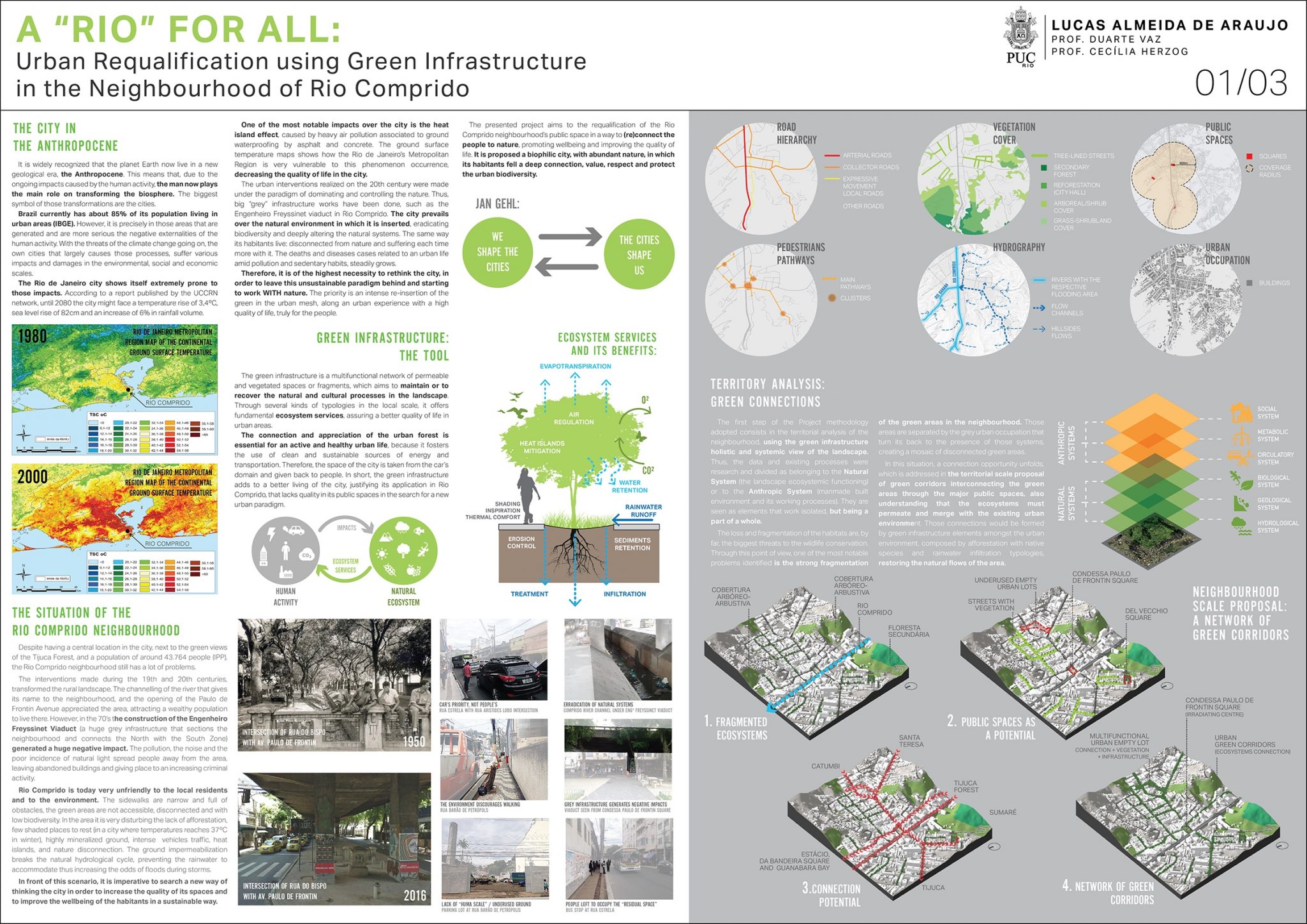
Guto sent me his proposal, initially named the “Low Line” along the canal, inspired by the High Line in New York City. In his vision, humans had priority over nature, and the canal would be covered to enable social activities—recreation, sports, arts and culture—over the water. He wanted to discuss his conceptual proposal. It was really stimulating to hear from an energized young architect who wanted to improve the bleak and forgotten urban space.
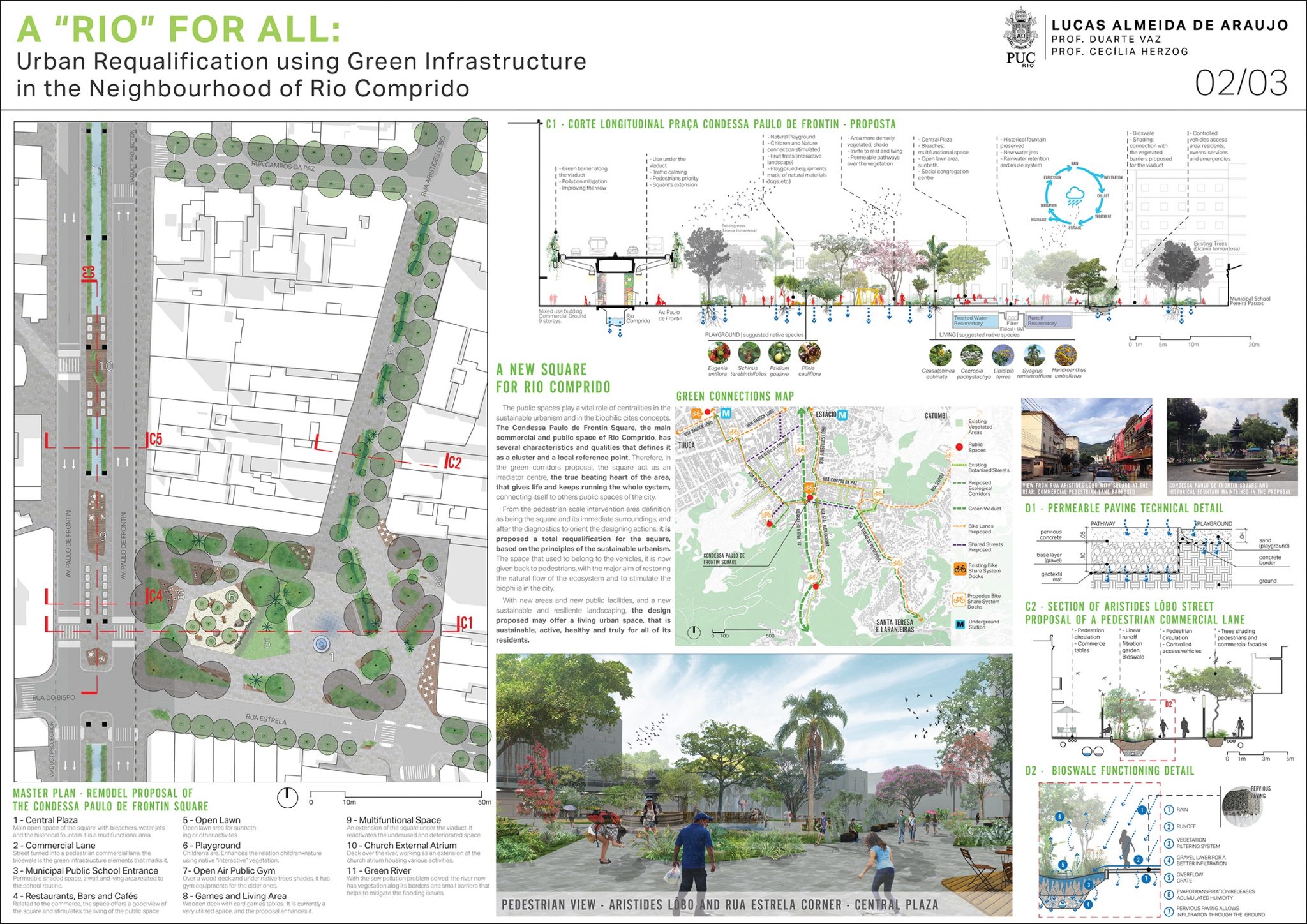

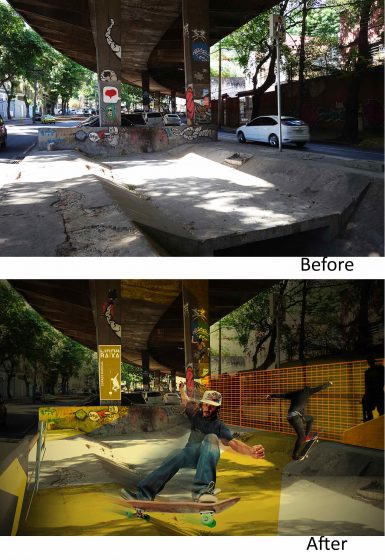
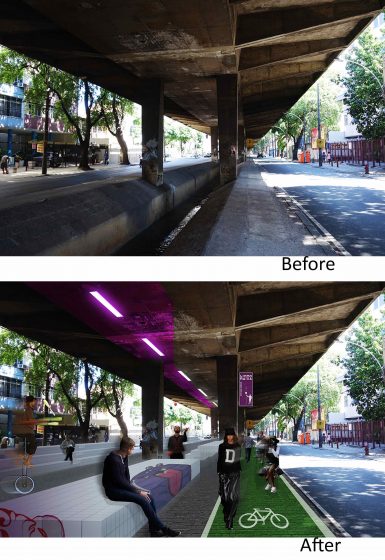
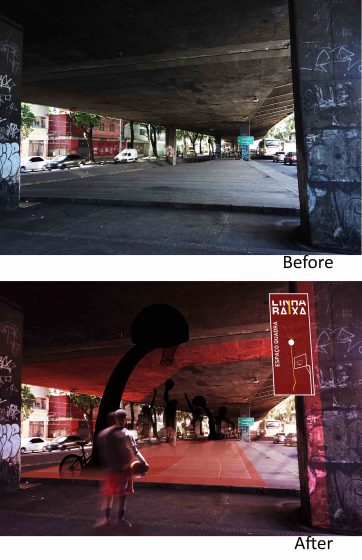
The next step was to meet the initial interdisciplinary team that was eager to transform the idea into a real project. I invited three students of the Master’s program I coordinate to join us, one environmental scientist and two landscape architects (Lucas was one of them, for sure!).
From that point on, some members became more active and visited the area in different times: weekdays, week-ends, days and evenings.
Guto went to the main square on a Saturday evening, during a street fair that has been occurring on the site for the last 20 years. There he met the organizer, Deise dos Santos, a woman who leads the neighborhood’s most dynamic NGO, Aliança Resgate Organização Não Governamental—Non Gonvernmental Organization Rescue Alliance (ARONG). ARONG focuses on kids from 4 years old, teaching dance, jiu-jitsu, music (to play several instruments), informatics, and other activities.
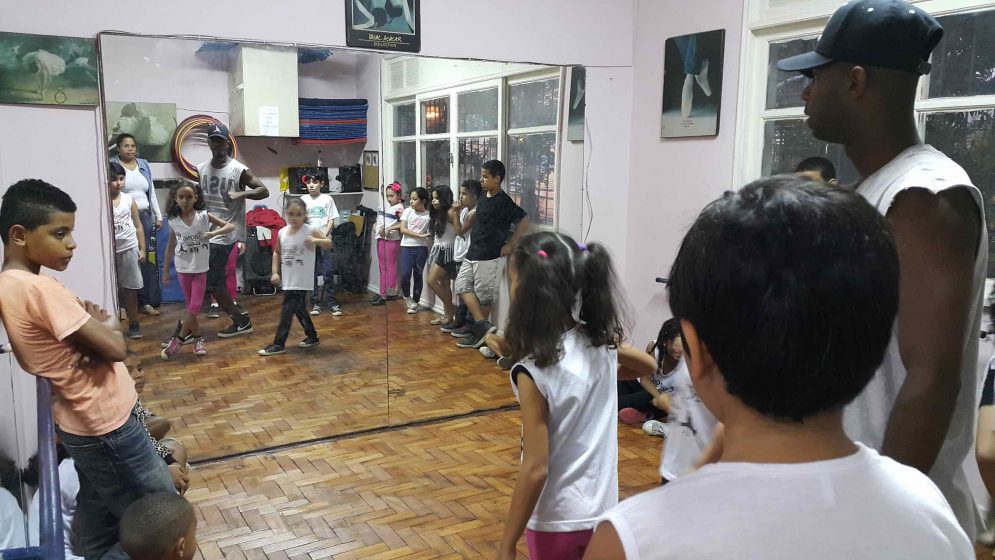
The street fair is organized to fund the NGO named ARONG. The local leader doesn’t get involved in the regional conflicts, kids from all distressed communities attend her organization’s classes and events. Their parents must participate; parental participation is a requirement of enrolling children in the learning sessions. The institution and the street fair are an oasis in a socially complex region.
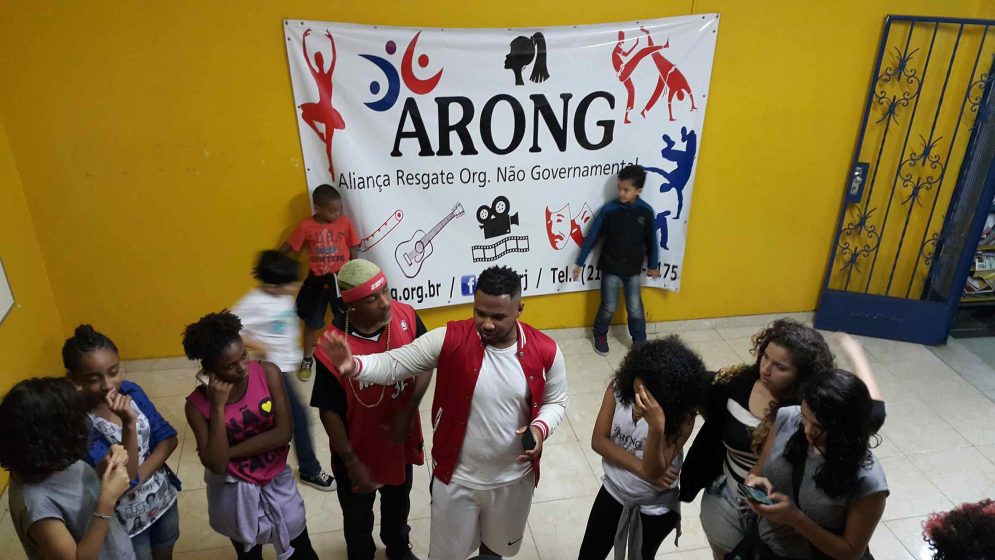
Connecting to the municipality
In the same week, I participated in a workshop organized by the Urban Planning Department, when I had a chance to talk with two Department employees, who also teach in the same university I do. They asked me if I had any proposal for Rio Comprido, the forgotten area for which we were planning the Baixo Rio. I was astonished! It seemed like things just started coming together naturally. Either the stars were aligning or it was in fact time to start to recovering a city that was falling apart?
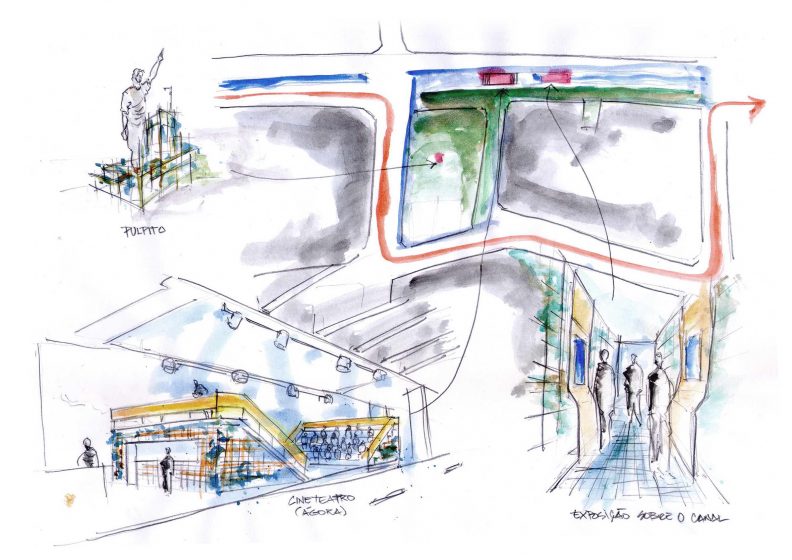
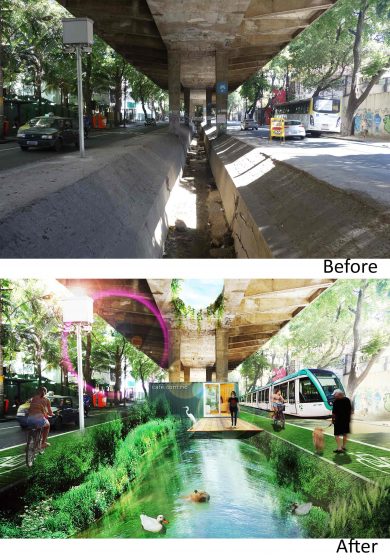
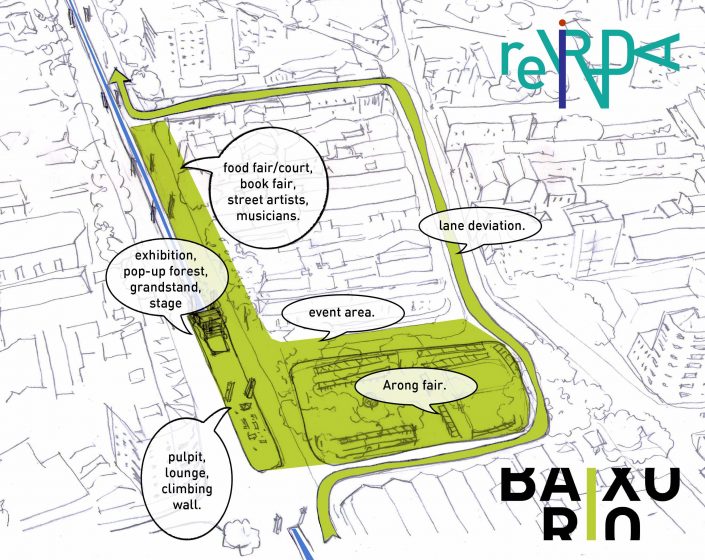
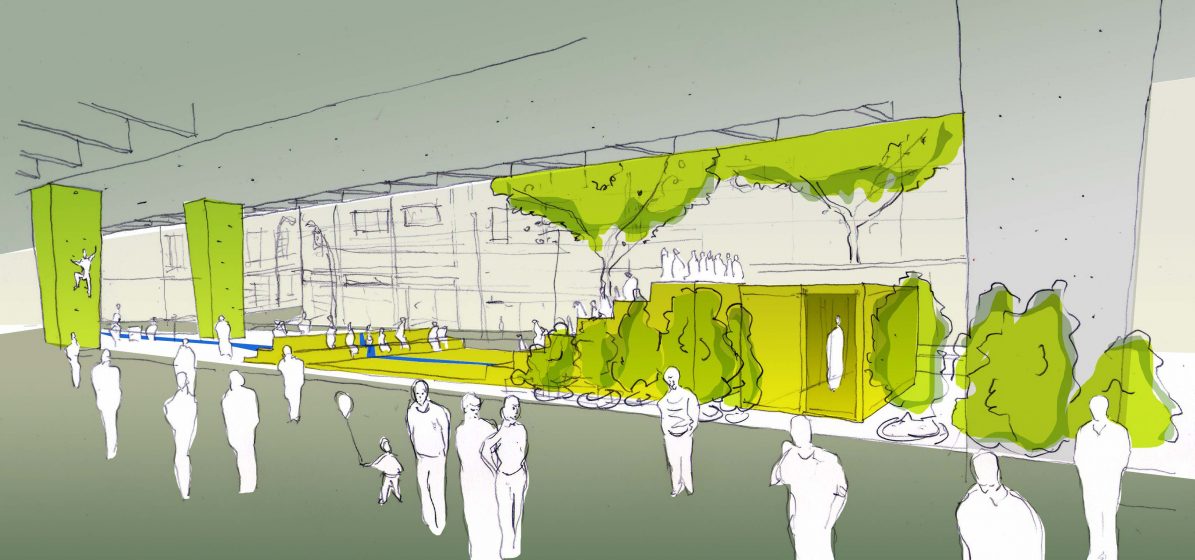
In a matter of days, we had a meeting in the City Hall to present our Baixo Rio proposition. We had developed a comprehensive vision for the future, and strategies to develop with a bottom-up approach. Lucas also presented his proposal, and nature came to the discussion as the main driver together with the social issues. The Department was also developing their own top-down project to introduce a bike lane under the viaduct. The prospects were very exciting!
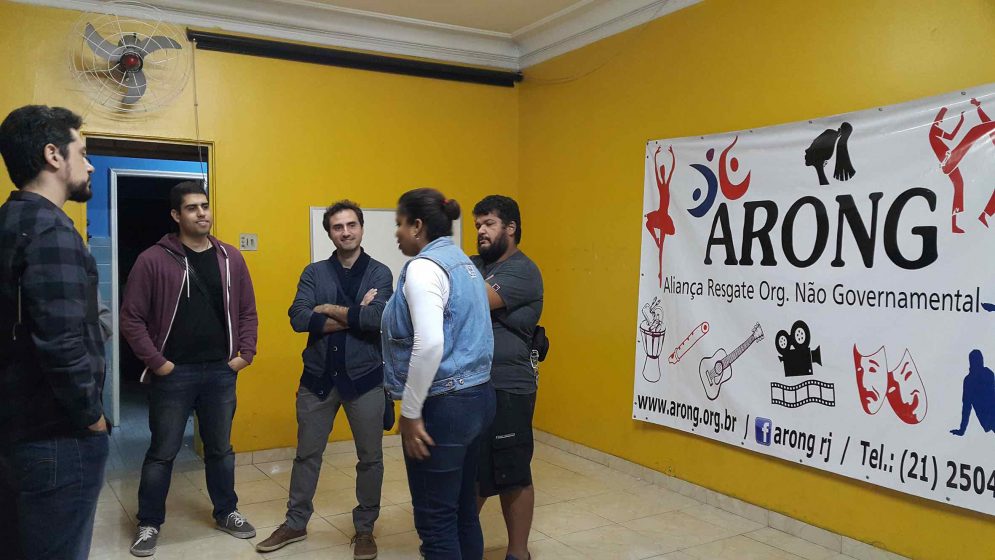
Time to meet local activists
It was time to visit the ARONG venue, a nice small house a few blocks from the main square. We wanted to be on the ground and experience the institutions’ activities. Deise received us with a big smile, she was proud to present the space and talk about her work. We could watch dance and hip hop classes. We saw the instruments hanging on the walls waiting for young musicians, the computers available to offer the opportunity to learn informatics, the small library in the entrance where the parents socialize waiting for their kids.
Sandro a local resident who volunteers at the ARONG also came to talk to us, and explain his involvement with the kids and the community. It was a very enlightening interview. We learned of many of their achievements, their aspirations for the area, and also confirmed some of our assumptions in the design of our project. They want priority for people over cars. The first demand was a bike lane to connect them to the neighboring regions. Loving plants and trees, they asked for more green areas. We talked about the canal and asked about what happens during storms. They complained of water pollution, and the frequent floods that happen in the area. They rejoiced when we spoke of introducing natural banks to the canal, and immediately started envisioning the transformation of the landscape. We also talked about closing streets to vehicles, and making areas more pedestrian-friendly. They loved the idea!
How to make things happen and when
So far, we have developed a methodology to work in four concurrent fronts (image diagram):
- Conceptual strategic urban landscape plan. Develop an adaptive long-term plan for the whole area along the canal and the immediate vicinity. Focus on social, ecological, cultural and economic factors, and climate change challenges, such as strong storms and Urban Heat Island (UHI) effects aggravated by heat waves. Involve: public institutions and the city, private companies (preference for small and local businesses) organized collective groups, and NGOs. Timing: Continuous process.
- Research and local projects. Learn and organize data about social, ecological and economic issues throughout the process. Design and promote short-term demonstration projects to help people visualize the potential uses and appropriation of the space, at the same time advocate for cultural and ecological restoration, and support economic development based on local and circular opportunities that exist in the area. Involve: academic institutions, organized collective groups, NGOs, companies and residents. Timing: Intermittent throughout the process.
- Events and interventions. Develop strategic comprehensive planned happenings, with plural cultural, artistic and educational purpose, to attract and enable: social diversity contact, ecological education and awareness raising, local economic activation, art performances, promote the strategic plan and learn from the residents, stimulate public support, spark and maintain the landscape transformation process. Promote ephemeral and permanent urban interventions that improve the public realm, and inspire the sense of community and belonging. Timing: Occasional—develop a yearly agenda.
- Management and financing. Involve public institutions and the city, and private companies (preference for small and local businesses) in the long-term management and financing of the long and short term plan and projects. Timing: Intermittent— related to the strategic plan, and the local projects, events and interventions.
First things first
While we are working on the strategic plan, we decided to promote a multipurpose event and intervention in the beginning of spring to kick off the transformation process, and engage the local community and businesses, potential sponsors and partners.
Rio de Janeiro has had a wave of successful events that occupy streets, mainly focused on food, beer, handcrafts and music. The most popular are oriented to local and organic products. We foresee a great potential to ally urban transformation with a multipurpose event. To make this project come through, we needed somebody to produce it. This is when Rafael Braga, known as an event producer, came to our team. We had a meeting to present the initial proposal and he immediately joined us.
The first event-intervention is ready to go. It is named reVIRADA BAIXO RIO (Turning Rio Upside Down – with double meaning: The neighborhood Rio Comprido and the city Rio de Janeiro).
Activities of the event:
- Social
- Environmental
- Educational
- Arts (music, dance, cinema, tehater, street art)
- Cultural and literary
- Sports
- Culinary and organic local food
- Cinema – Environmental Documentary projection in the square
The event aims to incentivize the local businesses through public space transformation, closing streets to cars and offering sitting and walking areas. This is one of the priorities: offering the experience of a new urban environment, even if ephemeral, to motivate effective project development and implementation.
Interventions in the urban space (to be implemented for the Spring event)
- Amphitheater – Low cost ephemeral structure aims to activate the area with multiple events (image). (Planned to stay for 60/90 days)
- Exhibition VISION Baixo Rio Comprido – a gallery will be set inside a refurbished container. (Planned to stay for 60/90 days)
The exhibition will present:
- Historical photographs of the Rio Comprido neighborhood
- VISION Baixo Rio Comprido 2020 and 2030: printed boards of the preliminary Strategic Conceptual Urban Landscape Plan
- VISION Baixo Rio Comprido 2030: virtual reality experience inside the gallery will show how the landscape would be transformed by 2030.
- Implemented or not international references of urban landscape transformations on printed boards. The objective is to show the great potential of the area and the city to residents, and other stakeholders.
- Pop-up Forest – Temporary green installation of riparian forest along the canal, and native species over paved surfaces.
- Graffiti in the concrete banks of the canal, over the paved areas that hide the canal to signalize the existence of water underneath, and the pillars that hold the flyover.
- Visual marks in paved surfaces, visually connecting walkable areas through streets (to be determined due to official restrictions).
- Pulpit – space dedicated to encourage participants to manifest themselves within the urban space, the propositions of the Vision Baixo Rio Comprido, and other ideas people desire to publicly share in order to improve their place and the city.
- Climbing wall – The two pillars of the flyover located in the main area will be converted to climbing walls.
- Lounge – sitting areas dedicated to convivial and social interaction.
Activities that will take place in the areas with interventions:
- Local Fair – ARONG (local NGO) fair will take place in the square as it has happened in the last 20 years, starting in the morning.
- Music and dance presentations of the ARONG students, in the amphitheater.
- Informal round-tables – Thematic chats with experts in urban issues, such as walkable cities, waters and biodiversity, social justice, sustainability, resilience, circular and local economy, in the amphitheater.
- Local and organic producers of food and drinks, in the closed streets.
- Food Trucks and Beer Fest, in the closed streets.
- Book Fair, in the closed streets.
- Street music players, throughout the pedestrian areas.
- Classical Music – Musicians of the Brazilian Symphony Orchestra to provide public performances, in the amphitheater.
- Organic food planting and workshop on urban agroforestry, in the square.
The way forward
I believe Baixo Rio presents a new opportunity to work from the bottom-up, together with Urban Planning and other city departments to enable a sustainable and participative urban transformation.
We received a green light from the city, and now we are raising funds and connecting with organizers for the many events planned to happen in less than 60 days.
This project allies many of my aspirations:
- urban landscape’s direct inter-relation with sustainability, resilience and quality of life and well-being
- prioritize nature in the city—waters and biodiversity
- aims to activate people’s biophilia together with arts, culture, organic food production and sales
- connect with local residents and grassroots movements
- awaken people to public health impacts caused by the urban environment, food and consumption
- stimulate local businesses focusing on reusing and recycling goods and value local knowledge and skills, such as secondhand clothes and thrift stores, shoe repair, electronic equipment restoration, handcrafts, and so on
- raise awareness about climate change challenges to engage dwellers in the process of adaptation based on ecosystems and community solutions
I am also trying to introduce the concept of the biophilic city to the decision makers and residents, and this project could be the first step in this direction, toward ultimately becoming a partner city of the Biophilic Cities Project. Let’s see what will happen next.
I feel like we are running a marathon to enable an urban transformation that may be a catalyzer for greater change in the city in the early future. We have so much to do in so little time, but the team is committed to make our vision come true. I am happy to be engaged in an urban project again, and hope the outcome will be positive.
Baixo Rio Team that is working to TURN THE CITY UPSIDE DOWN in alphabetical order:
Amanda Saboya
Bruno d’Acri
Cecilia Polacow Herzog
Cesar Rodrigues
Gabriel Queiros
Guto Santos
Lucas Araújo
Marina Christiansen
Pedro Schreiber Ribeiro
Rafael Braga
Cecilia Herzog
Rio de Janeiro
[1] I have written about my experiences and perceptions about the perverse process of planning, designing and implementing the huge projects in preparation for the international events in my blog https://ceciliaherzog.wordpress.com
* * * * *
Virando o Rio de cabeça para baixo! Projeto de Transformação de Paisagem Urbana do Baixo Rio
(Traduzido por Cecilia Herzog.)
Cerca de quinze anos atrás eu me apaixonei pelas bacias hidrográficas. Então, minha paixão se estendeu às florestas e aos ecossistemas que os sustentam. Então, descobri as águas urbanas e a biodiversidade, e conseqüentemente a ecologia urbana, quando comecei a pesquisar em infraestrutura azul-verde urbana e como as pessoas se relacionavam com seu meio ambiente. A partir de então, a paisagem urbana complexa levou-me a um mundo novo onde as questões sociais e ecológicas estão entrelaçadas, e oferecem um universo incrível para pesquisar, aprender e se conectar a outras pessoas envolvidas na transformação de cidades em todas as escalas.
Fiquei fascinado sobre como movimentos de base e abordagens de baixo para cima têm mudado paisagens em muitas cidades. Ao mesmo tempo, fiquei muito frustrado de que, na minha cidade, no Rio de Janeiro, as pessoas não quebraram a bolha dos poderosos decisores na preparação para sediar os eventos esportivos internacionais: 2014 Copa do Mundo de Futebol e Jogos Olímpicos de 2016. Os arranjos que privilegiaram algumas empresas sempre foram levados a portas fechadas. Os resultados são expressos em uma cidade violenta e negligenciada. As razões estão sendo reconhecidas durante o processo de investigações sobre o enorme escândalo de investimentos que se concentrou na cidade como um grande negócio para poucas pessoas poderosas. A corrupção bloqueou todos os movimentos de base para participar e escolher projetos mais ecológicos e mais sustentáveis, inclusive aqueles em que participei. Como já escrevi sobre o TNOC, muitos sonhos e movimentos que participei nos últimos 5 anos não saíram do papel.
Agora, tenho a oportunidade de aplicar meu conhecimento e experiência em um novo empreendimento que visa transformar a paisagem urbana, conectar pessoas, águas e biodiversidade, orientadas para empresas locais, com produção de alimentos, artes e cultura.
É uma chance de transformar a cidade em uma cidade biofílica! Sou membro do Comitê Diretor do Projeto Biophlic Cities, liderado por Timothy Beatley (que também é colaborador da TNOC com vários ensaios sobre o tema), que exige o papel da natureza na cidade como prioridade para torná-lo Viváveis, sustentáveis, resistentes e oferecem alta qualidade de vida e bem-estar. Em suas palavras: “Uma cidade biofílica é uma cidade natural. Ele coloca a natureza no cerne do seu projeto e planejamento, não como uma reflexão tardia ou um ornamento. É a chave para tudo o que acontece na cidade “.
Baixo Rio, é um experimento em transformação urbana participativa
Bairro de Rio Comprido
Neste artigo, vou me concentrar em um caso específico de transformação urbana em que estou envolvido agora. Está localizado no Rio de Janeiro. É uma área desafiadora chamada Rio Comprido (Long River). Abaixo está um breve esboço do contexto atual do bairro e desafios com poluição e habitabilidade:
- O bairro dividido por um longo viaduto, ou canal, o que resta de um rio Comprido desviado e canalizado
- Derelição e negligência
- O canal é estreito e a água é poluída por esgoto e contaminação difusa pelo escoamento da água da chuva
- As inundações ocorrem durante as tempestades, devido às encostas íngremes que cercam a área e a extensa pavimentação da cobertura do solo
- O canal não é visível para as pessoas que dirigem o voo superiorCongestionamento de tráfego pesado durante a semana sob a ponte
- Ruas fantasmas sem pessoas na maioria das vezes, especialmente durante os fins de semana
- Não são amigáveis para caminhar, os carros e os ônibus têm prioridade total e não têm qualquer atratividade.
- Rodeado por 22 comunidades de baixa renda (favelas), onde as gangues lutam uma contra a outra, e os moradores temem por suas vidas
- O bairro é inseguro (na verdade, hoje em dia, toda a cidade é insegura – o exército foi chamado para tentar colocar algum pedido onde traficantes de drogas e milícias são os principais governantes da maior parte do território urbano)
- Extremamente barulhento
- O ar está fortemente poluído
Apesar desses desafios, há uma grande oportunidade para regenerar a paisagem urbana adjacente ao canal e se espalhar para a vizinhança. Além das áreas residenciais mestiças de baixa e baixa renda, o bairro abriga pequenas empresas, grandes empresas e instituições educacionais que sofreram com a violência que afeta direta ou indiretamente suas operações.
Proposição acadêmica
Cerca de dois anos atrás, Lucas Araújo, um estudante de graduação em arquitetura e urbanismo pediu-me para ser seu co-assessor em seu projeto final. Ele queria desenvolver um plano e design para infra-estrutura verde em uma área que foi extremamente impactada pela engenharia rígida e dura do início do século XX, quando o rio Comprido que nomeia o bairro foi desviado e canalizado para permitir a urbanização e construção de Ruas em seus dois bancos de concreto recém-construídos. No início da década de 1970, a abertura de um túnel para conectar as regiões norte e sul da cidade levou à construção de um viaduto de 2,6 km de extensão sobre o canal, dividindo e destruindo o bairro agradável perto da região do centro da cidade.
A mudança foi abrupta e a área tornou-se um concreto e um asfalto “em nenhum lado”, onde carros e ônibus circulam em um ambiente sombrio e poluído, não adequado para a vida. A área foi decadente nas últimas cinco décadas e nada foi feito para mudar a paisagem inóspita.
Durante o ano seguinte, tive a oportunidade de aprender sobre a área, os desafios e as oportunidades que estavam escondidas sob a rodovia elevada. Lucas desenvolveu um processo muito interessante para realizar seu projeto desafiador. Durante o curso de graduação, os alunos têm contato muito limitado com a arquitetura paisagística e o planejamento e o design da paisagem. Apesar dessas limitações acadêmicas, o plano resultante foi uma proposta robusta fundada nos sistemas ecológicos e sociais do “vizinho” (bacia hidrográfica + bairro). O projeto centrou-se na praça principal da área, conectou ambos os lados do canal, converteu ruas em áreas pedestres com componentes de infra-estrutura verde local, como jardins de chuva e bioswales, bancos de rios naturalizados e muito mais.



Baixo Rio: vendo a cidade de cabeça para baixo
Em junho passado, recebi um e-mail de Guto Santos (Arquiteto-Urbanista, diretor de Livre Arquitetura), dizendo-me como era apaixonado e motivado para transformar a área negligenciada, Rio Comprido. Ele havia trabalhado por cerca de 5 anos em um escritório localizado perto do final do canal e tinha caminhado na região prevendo o potencial desperdiçado pelos tomadores de decisão míope que concentraram seus investimentos no aumento da expansão da cidade e Não teve interesse em revitalizar as áreas urbanas degradadas com infra-estrutura próxima ao centro da cidade.

Guto me enviou sua proposta, inicialmente chamada de “Linha baixa” ao longo do canal, inspirada na High Line da cidade de Nova York (imagens). Em sua visão, os humanos tinham prioridade sobre a natureza, e o canal seria coberto para permitir atividades sociais – recreação, esportes, artes e cultura – sobre a água. Ele queria discutir sua proposta conceitual. Era realmente estimulante ouvir de um jovem arquiteto energizado que queria melhorar o espaço urbano sombrio e esquecido.





Durante a nossa primeira reunião, escutei todas as idéias que desenvolveu ao longo dos anos, e como ele estava reunindo pessoas interessadas em intervenção urbana. O nome do projeto tornou-se Baixo Rio. Low River, que no Rio de Janeiro tem um duplo significado: tanto rio baixo como um lugar de encontro onde os cariocas, moradores da cidade se encontram). Ele explicou como as intervenções acupunturais destinadas a ativar nós específicos espalhariam a vida ao longo da “Linha baixa”. Perguntei por que sobre a água e não nas pistas dedicadas ao carro, uma vez que hoje a tendência é a luz do dia rios e tirar carros das ruas, dando prioridade às pessoas e à natureza. Após nossa conversa, ele começou a entender o papel da natureza (água e biodiversidade) na cidade. Naquele momento, decidi me juntar à equipe para contribuir com minhas habilidades de rede e visão sistêmica da paisagem, onde as áreas verdes e os fluxos naturais são essenciais para a sustentabilidade e a resiliência da cidade, além de oferecer uma melhor qualidade de vida e bem-estar. É também uma questão de justiça social para trazer melhores condições ambientais para a região.
O próximo passo foi encontrar a equipe interdisciplinar inicial que estava ansiosa para transformar a idéia em um projeto real. Convidei três alunos do programa de mestrado que eu coordenar para se juntar a nós, um cientista ambiental e dois arquitetos paisagistas (Lucas era um deles, com certeza!).
A partir desse momento, alguns membros se tornaram mais ativos e visitaram a área em diferentes momentos: dias da semana, fins de semana, dias e noites.
Guto foi para a praça principal em uma noite de sábado, durante uma feira de rua que tem ocorrido no site há 20 anos. Lá conheceu o organizador, Deise dos Santos, uma mulher que lidera a ONG mais dinâmica do bairro, Aliança Resgate Organização Não Governamental – Aliança de Resgate da Organização Não Governamental (ARONG). ARONG se concentra em crianças de 4 anos, ensino de dança, jiu-jitsu, música (para tocar vários instrumentos), informática e outras atividades. A feira de rua é organizada para financiar a ONG chamada ARONG (imagens). O líder local não se envolve nos conflitos regionais, crianças de todas as comunidades em dificuldades atendem as aulas e eventos da organização. Os pais devem participar; A participação dos pais é um requisito de matricular crianças nas sessões de aprendizagem. A instituição e a feira de rua são um oásis em uma região socialmente complexa.


Conectando-se ao município
Na mesma semana, participei de uma oficina organizada pelo Departamento de Planejamento Urbano, quando tive a oportunidade de conversar com dois funcionários do Departamento, que também ensinam na mesma universidade que eu faço. Eles me perguntaram se eu tinha alguma proposta para Rio Comprido, a área esquecida para a qual estávamos planejando o Baixo Rio. Fiquei atônito! Parecia que as coisas simplesmente começaram a se juntar naturalmente. Ou as estrelas estavam se alinhando ou, de fato, era hora de começar a recuperar uma cidade que se desmoronava?




Em uma questão de dias, tivemos uma reunião na Prefeitura para apresentar nossa proposição do Baixo Rio. Nós desenvolvemos uma visão abrangente para o futuro e estratégias para desenvolver com uma abordagem ascendente (imagens). Lucas também apresentou sua proposta, e a natureza veio à discussão como principal motorista junto com as questões sociais. O Departamento também estava desenvolvendo seu próprio projeto de cima para baixo para introduzir uma pista de bicicleta sob o viaduto. As perspectivas foram muito emocionantes!
Tempo para se encontrar com ativistas locais

Era hora de visitar o local de ARONG, uma linda casa pequena a poucos quarteirões da praça principal. Queríamos estar no terreno e experimentar as atividades das instituições. Deise nos recebeu com um grande sorriso, ela estava orgulhosa de apresentar o espaço e falar sobre seu trabalho. Poderíamos assistir a aulas de dança e hip hop. Vimos os instrumentos pendurados nas paredes esperando por jovens músicos, os computadores disponíveis para oferecer a oportunidade de aprender informática, a pequena biblioteca na entrada onde os pais socializam.
Sandro, um residente local que se ofereceu no ARONG, também veio falar conosco e explicou seu envolvimento com as crianças e a comunidade. Foi uma entrevista muito esclarecedora. Aprendemos muitas de suas conquistas, suas aspirações para a área e também confirmamos algumas das nossas premissas no projeto do nosso projeto. Eles querem prioridade para pessoas em cima de carros. A primeira demanda foi uma pista de bicicleta para conectá-los às regiões vizinhas. Amando plantas e árvores, eles pediram mais áreas verdes. Nós conversamos sobre o canal e perguntamos sobre o que acontece durante as tempestades. Eles reclamaram da poluição da água e das inundações frequentes que acontecem na área. Eles se alegraram quando falamos sobre a introdução de bancos naturais para o canal, e imediatamente começamos a imaginar a transformação da paisagem. Nós também conversamos sobre fechar ruas para veículos e fazer áreas mais favoritas para os pedestres. Eles adoraram a idéia!
Como fazer as coisas acontecerem e quando
Até agora, desenvolvemos uma metodologia para trabalhar em quatro frentes simultâneas (diagrama de imagem):
- Plano estratégico estratégico de paisagem urbana. Desenvolva um plano adaptativo a longo prazo para toda a área ao longo do canal e da vizinhança imediata. Concentre-se em fatores sociais, ecológicos, culturais e econômicos e desafios das mudanças climáticas, como tempestades fortes e efeitos da Ilha do calor urbano (UHI) agravados pelas ondas de calor. Envolver: instituições públicas e a cidade, empresas privadas (preferência por empresas pequenas e locais) organizaram grupos coletivos e ONGs. Tempo: processo contínuo.
- Projetos de pesquisa e locais. Aprenda e organize dados sobre questões sociais, ecológicas e econômicas ao longo do processo. Projetar e promover projetos de demonstração de curto prazo para ajudar as pessoas a visualizar os possíveis usos e apropriação do espaço, ao mesmo tempo que defendem a restauração cultural e ecológica e apoiem o desenvolvimento econômico com base em oportunidades locais e circulares que existem na área. Envolver: instituições acadêmicas, grupos coletivos organizados, ONGs, empresas e residentes. Temporização: intermitente ao longo do processo.
- Eventos e intervenções. Desenvolver eventos planejados estratégicos abrangentes, com propósitos culturais, artísticos e educacionais plurais, para atrair e permitir: contato de diversidade social, educação ecológica e conscientização, ativação econômica local, performances artísticas, promover o plano estratégico e aprender com os residentes, estimular o apoio público , Faísca e mantém o processo de transformação da paisagem. Promover intervenções urbanas efêmeras e permanentes que melhorem o domínio público e inspiram o senso de comunidade e pertença. Calendário: Ocasionalmente, desenvolva uma agenda anual.
- Gestão e financiamento. Envolver as instituições públicas e a cidade, e as empresas privadas (preferência por empresas pequenas e locais) na gestão e financiamento de longo prazo do plano e projetos de longo e curto prazo. Calendário: intermitente – relacionado ao plano estratégico, e projetos locais, eventos e intervenções.
Primeiras coisas primeiro
Enquanto estamos trabalhando no plano estratégico, decidimos promover um evento polivalente e uma intervenção no início da primavera para iniciar o processo de transformação e envolver a comunidade local e as empresas, potenciais patrocinadores e parceiros.
O Rio de Janeiro teve uma onda de eventos bem sucedidos que ocupam ruas, principalmente focadas em alimentos, cerveja, artesanato e música. Os mais populares são orientados para produtos locais e orgânicos. Prevemos um grande potencial para a transformação urbana aliada com um evento multifuncional. Para que este projeto venha, precisamos de alguém para produzi-lo. Foi quando Rafael Braga, conhecido como produtor de eventos, chegou ao nosso time. Tivemos uma reunião para apresentar a proposta inicial e ele imediatamente se juntou a nós.
O primeiro evento-intervenção está pronto para ir. É chamado reVIRADA BAIXO RIO (Turning Rio Upside Down – com duplo significado: o bairro Rio Comprido e a cidade do Rio de Janeiro).
Atividades do evento:
- Social
- De Meio Ambiente
- Educacional
- Artes (música, dança, cinema, teatro, arte de rua)
- Cultural e literário
- Esportes
- Comida local culinária e orgânica
- Cinema – Projeção documental ambiental na praça
O evento visa incentivar as empresas locais através da transformação do espaço público, fechando ruas para carros e oferecendo áreas sentadas e a pé. Esta é uma das prioridades: oferecer a experiência de um novo ambiente urbano, mesmo que seja efêmero, para motivar o desenvolvimento e a implementação eficazes de projetos.
Intervenções no espaço urbano (a ser implementado para o evento Spring)
- Anfiteatro – Estrutura efêmera de baixo custo tem como objetivo ativar a área com múltiplos eventos (imagem). (Planejado para ficar por 60/90 dias)
- Exposição VISÃO Baixo Rio Comprido – uma galeria será configurada dentro de um recipiente recondicionado. (Planejado para ficar por 60/90 dias)
A exposição apresentará:
- Fotografias históricas do bairro de Rio Comprido
- VISÃO Baixo Rio Comprido 2020 e 2030: placas impressas do Plano Estratégico Estratégico Estratégico de Paisagem Urbana
- VISÃO Baixo Rio Comprido 2030: experiência de realidade virtual dentro da galeria mostrará como a paisagem seria transformada até 2030.
- Implementou ou não referências internacionais de transformações de paisagem urbana em placas impressas. O objetivo é mostrar o grande potencial da área e da cidade para os moradores e outras partes interessadas.
- Floresta Pop-up – Instalação temporária verde da floresta ripária ao longo do canal e espécies nativas sobre superfícies pavimentadas.
- Graffiti nos bancos de concreto do canal, sobre as áreas pavimentadas que escondem o canal para sinalizar a existência de água por baixo, e os pilares que mantêm o sobrevoo.
- Marcas visíveis em superfícies pavimentadas, conectando visualmente áreas móveis através de ruas (a serem determinadas devido a restrições oficiais).
- Púlpito – espaço dedicado a incentivar os participantes a se manifestarem no espaço urbano, as proposições da Visão Baixo Rio Comprido e outras idéias que as pessoas desejam compartilhar publicamente para melhorar seu lugar e a cidade.
- Parede de escalada – Os dois pilares do sobreviver localizado na área principal serão convertidos em paredes de escalada.
- Lounge – áreas de estar dedicadas à interação convivial e social.
Atividades que terão lugar nas áreas com intervenções:
- Feira local – A feira ARONG (ONG local) terá lugar na praça, como aconteceu nos últimos 20 anos, começando pela manhã.
- Apresentação de música e dança dos alunos de ARONG, no anfiteatro.
- Mesas redondas informais – Chats temáticos com especialistas em questões urbanas, como cidades itinerantes, águas e biodiversidade, justiça social, sustentabilidade, resiliência, economia circular e local, no anfiteatro.
- Produtores locais e orgânicos de alimentos e bebidas, nas ruas fechadas.
- Food Trucks and Beer Fest, nas ruas fechadas.
- Feira do Livro, nas ruas fechadas.
- Jogadores de música de rua, em todas as áreas pedestres.
- Música clássica – Músicos da Orquestra Sinfônica Brasileira para oferecer performances públicas, no anfiteatro.
- Plantação de alimentos orgânicos e workshop sobre agrossilvicultura urbana, na praça.
O caminho a seguir
Acredito que o Baixo Rio apresenta uma nova oportunidade de trabalhar de baixo para cima, junto com o Urbanismo e outros departamentos da cidade para permitir uma transformação urbana sustentável e participativa.
Recebemos uma luz verde da cidade, e agora estamos arrecadando fundos e conectando-se com os organizadores para os muitos eventos planejados para acontecer em menos de 60 dias.
Este projeto alias muitas das minhas aspirações:
- Inter-relação direta da paisagem urbana com sustentabilidade, resiliência e qualidade de vida e bem-estar
- priorizar a natureza nas cidades-águas e biodiversidade
- visa ativar a biofilia das pessoas junto com artes, cultura, produção de alimentos orgânicos e vendas
- conectar-se com residentes locais e movimentos de base
- despertar as pessoas para os impactos da saúde pública causados pelo ambiente urbano, alimentação e consumo
- estimular as empresas locais concentrando-se na reutilização e reciclagem de bens e valorizam conhecimentos e habilidades locais, como roupas de segunda mão e lojas de segunda mão, reparação de calçados, restauração de equipamentos eletrônicos, artesanato e assim por diante
- aumentar a conscientização sobre os desafios das mudanças climáticas para envolver os moradores no processo de adaptação baseado em ecossistemas e soluções comunitárias
Também estou tentando introduzir o conceito de cidade biofílica para os tomadores de decisão e os residentes, e este projeto pode ser o primeiro passo nessa direção, e talvez se tornar uma cidade parceira do Projeto Biophilic Cities. Vamos ver o que acontecerá depois.
Eu sinto que estamos executando uma maratona para permitir uma transformação urbana que pode ser um catalisador para uma maior mudança na cidade no início do futuro. Temos muito a fazer em tão pouco tempo, mas a equipe está empenhada em tornar a nossa visão realidade. Estou feliz em me envolver novamente em um projeto urbano e espero que o resultado seja positivo.
Baixo Rio Equipe que está trabalhando para girar a cidade antes
em ordem alfabética:
Amanda Saboya
Bruno d’Acri
Cecilia Polacow Herzog
Cesar Rodrigues
Gabriel Queiros
Guto Santos
Lucas Araújo
Marina Christiansen
Pedro Schreiber Ribeiro
Rafael Braga
Cecilia Herzog
Rio de Janeiro
1 — Eu escrevi sobre minhas experiências e percepções sobre o processo perverso de planejar, projetar e implementar os enormes projetos em preparação para os eventos internacionais no meu blog: https://ceciliaherzog.wordpress.com


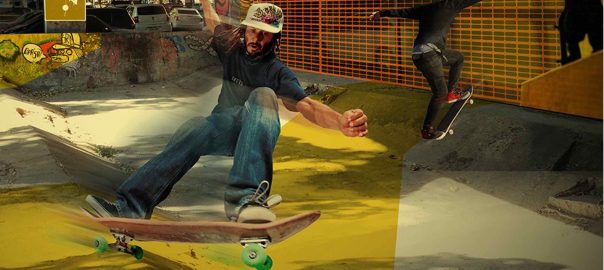
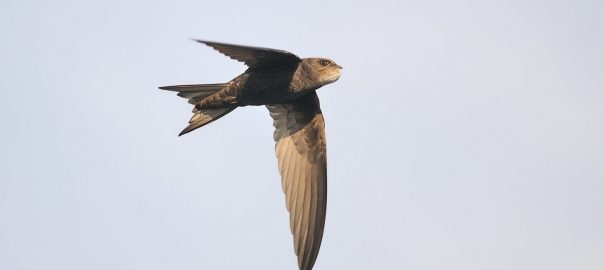
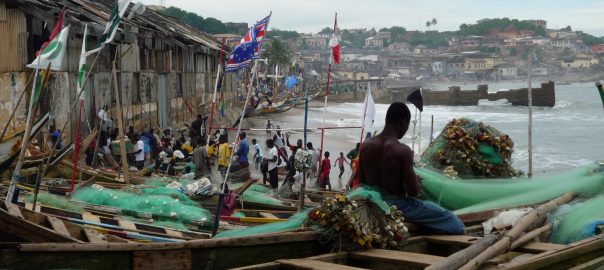
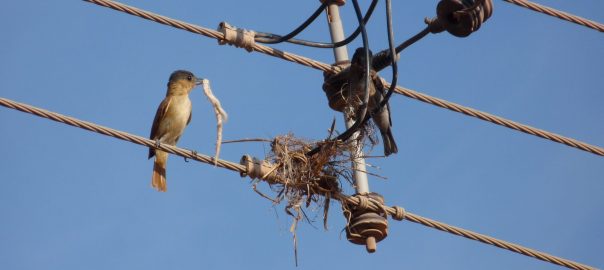
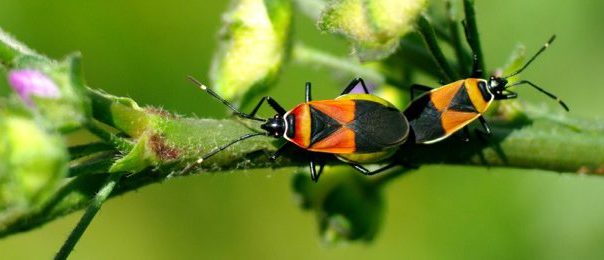
Leave a Reply